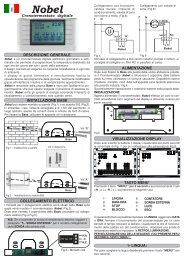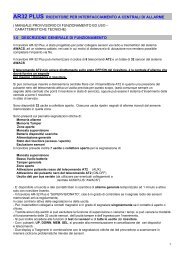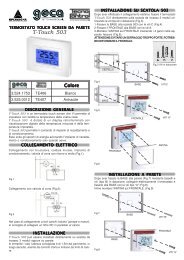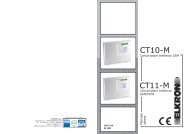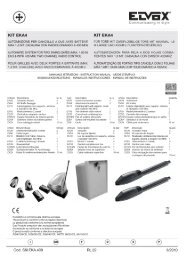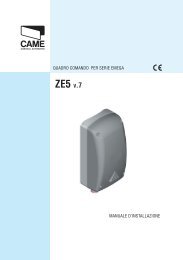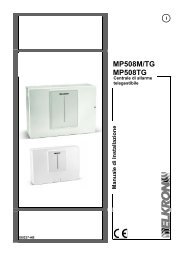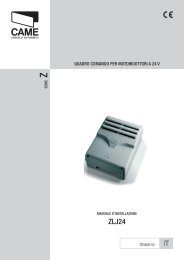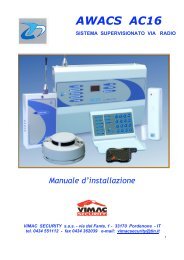Applications examples - Mgelettroforniture
Applications examples - Mgelettroforniture
Applications examples - Mgelettroforniture
You also want an ePaper? Increase the reach of your titles
YUMPU automatically turns print PDFs into web optimized ePapers that Google loves.
SICUREZZA<br />
GAS - GAS DETECTION<br />
Esempi applicativi<br />
<strong>Applications</strong> <strong>examples</strong><br />
Impianti frigoriferi / Refrigerating plants<br />
Nelle strutture per la produzione di alimenti o per il loro stoccaggio, ove sia necessaria la<br />
conservazione del prodotto primario o finito a temperatura controllata, normalmente il fluido<br />
refrigerante usato è l’ammoniaca.<br />
Si tratta di grandi strutture ove altri fluidi non permetterebbero l’uso di potenze così elevate.<br />
GAS PRESENTI<br />
Ammoniaca (NH 3<br />
): Contenuta nell’impianto di refrigerazione, potrebbe potenzialmente uscire da<br />
ogni interruzione meccanica lungo il circuito, in particolare, è sensibile la zona degli evaporatori<br />
esistenti in ogni cella ed il locale tecnico dei compressori, dove la grande quantità presente<br />
potrebbe dare luogo a miscele infiammabili oltre che tossiche.<br />
RISCHIO ATTESO<br />
NH 3<br />
: A temperatura ambiente l’ammoniaca è un gas incolore dall’odore pungente molto forte e<br />
soffocante, è irritante, infiammabile e tossica. L’ammoniaca ha azione irritante sulle mucose della<br />
congiuntiva, delle narici e della faringe a funzione ustionante. L’ammoniaca ha In presenza di<br />
ossigeno (all’aria) può intaccare l’alluminio il rame, il niche e le loro leghe.<br />
In plants where foodstuff are produced and stocked, where primary or finished products need to be<br />
preserved at a controlled temperature, the most common cooling liquid is ammonia.<br />
It is big plants where other fluids would not enable to use such high power.<br />
GASES INVOLVED<br />
Ammonia (NH 3<br />
): contained in cooling systems, potentially it might come out from every mechanical<br />
joint along the circuit; the area of evaporators, which are contained in every cell, and he technical<br />
room of compressors are particularly critical, as the big amount of liquid might create flammable<br />
and toxic mixtures.<br />
EXPECTED RISKS<br />
NH 3<br />
: colourless, with an irritating, sharp smell, inflammable, toxic. Ammonia irritates the mucosa of<br />
the conjunctiva, nostrils and pharynx through a scalding action. Moreover, ammonia has a general<br />
scalding action.<br />
PRODOTTI DA USARE<br />
PRODUCTS TO USE<br />
Rilevazione NH 3<br />
NH 3<br />
detection<br />
TS220EAH<br />
TS293EAH<br />
TS292P<br />
TS293P<br />
96




